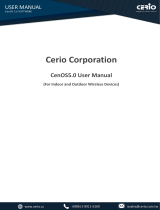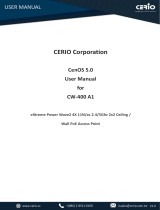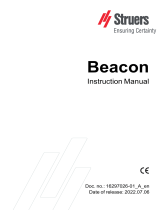Page is loading ...

v1.0b
CERIO Corporation
IW-100 A1
eXtreme Wave 2 11n/ac 2.4/5Ghz 2x2 In Wall PoE
Access Point ( 100mW )
User’s Manual

v1.0b
This device has been tested and found to comply with limits for a Class A digital device, pursuant to Part 2 and
15 of the FCC Rules. These limits are designed to provide reasonable protection against harmful interference
when the equipment is operated in a commercial environment. This equipment generates, uses and can
radiates radio frequency energy and, if not installed and used in accordance with the user’s manual, may cause
interference in which case user will be required to correct the interference at his own expense.
This is a Class A product. In a domestic environment, this product may cause radio
interference in which case the user many be required to take adequate measures.
CE Mark Warning
FCC Warning

v1.0b
1. Introduction ...................................................................................................................................... 6
1.1 Software Configuration ................................................................................................. 6
1.2 Login IW-100 A1 Web Page .......................................................................................... 9
2. Software Setting ........................................................................................................................... 10
2.1 Operating Mode Introduction .................................................................................... 10
3. Access Point mode ...................................................................................................................... 14
3.1 Configuration AP Mode ............................................................................................... 14
3.2 VLAN Setup .................................................................................................................... 14
3.2.1 Network Button ..................................................................................................... 15
3.2.2 Network Pull-down menu ................................................................................... 16
# DHCP Server ....................................................................................................................... 16
# Radio 0/1 Access Point .................................................................................................... 18
# MAC Filter ............................................................................................................................. 20
3.3 Authentication ............................................................................................................... 21
# Authentication Button: ......................................................................................................... 21
# Authentication Dropdown Button ...................................................................................... 23
3.3.1 Guest ........................................................................................................................ 23
3.3.2 Local User............................................................................................................... 24
3.3.3 OAuth2.0 ................................................................................................................. 25
※
Sample for Google OAuth2.0 setup .................................................................. 25
※
Sample for Facebook OAuth2.0 setup ............................................................. 28
3.3.4 PoP3/IMAP Server ................................................................................................ 32
3.3.5 Customize Page .................................................................................................... 33
3.3.6 Language ................................................................................................................ 35
3.3.7 Walled Garden ....................................................................................................... 35
3.3.8 Privilege Address ................................................................................................. 35
3.3.9 Bulk MAC Address ............................................................................................... 36
3.3.10 Profile....................................................................................................................... 37
3.4 RADIUS Server .............................................................................................................. 37
3.5 Radius Account Setup ................................................................................................ 38
3.6 Wireless Basic Setup................................................................................................... 39
3.6.1 Radio 0 Basic Setup (2.4G) ................................................................................ 39
3.6.2 Radio 1 Basic Setup (5G) ................................................................................... 41

v1.0b
3.6.3 Advanced Setup .................................................................................................... 42
3.6.4 WMM Setup ............................................................................................................ 45
4. CAP Mode ....................................................................................................................................... 47
4.1 System VLAN Setup..................................................................................................... 47
4.2 AP Control ...................................................................................................................... 50
# Centralized Management APs operating Instructions: .................................................. 50
4.2.1 Scan Device ........................................................................................................... 50
4.2.2 Batch Setup ............................................................................................................ 52
4.2.3 AP Setup ................................................................................................................. 54
4.2.4 Group Setup ........................................................................................................... 55
4.2.5 Map Setup ............................................................................................................... 55
4.2.6 Authentication Profile ......................................................................................... 58
5. Client Bridge Mode....................................................................................................................... 59
5.1 Configure LAN Setup................................................................................................... 60
5.2 Configure DHCP Setup ............................................................................................... 61
5.3 Wireless General Setup .............................................................................................. 63
5.3.1 Radio 0(2.4G) Basic Setup ................................................................................. 64
5.3.2 Radio 1(5G) Basic Setup..................................................................................... 65
5.3.3 Advanced Setup .................................................................................................... 67
5.3.4 WMM Setup ............................................................................................................ 69
5.3.5 Station Setup ......................................................................................................... 71
5.3.6 2.4G/5G AP Setup(Repeater) ............................................................................. 72
5.3.7 MAC Filter ............................................................................................................... 74
6. WISP Mode ..................................................................................................................................... 75
6.1 Configure WAN Setup ................................................................................................. 75
6.2 Configure LAN Setup................................................................................................... 79
6.3 Configure DHCP Server .............................................................................................. 79
6.4 Wireless General Setup .............................................................................................. 82
6.4.1 Radio 0(2.4G) Basic Setup ................................................................................. 82
6.4.2 Radio 1(5G) Basic Setup..................................................................................... 84
6.4.3 Advanced Setup .................................................................................................... 85
6.4.4 WMM Setup ............................................................................................................ 87
6.4.5 Station Setup ......................................................................................................... 90
6.4.6 2.4G/5G AP Setup(Repeater) ............................................................................. 91
6.4.7 MAC Filter ............................................................................................................... 92
6.5 Configure Advanced Setup ........................................................................................ 93
6.5.1 DMZ .......................................................................................................................... 93

v1.0b
6.5.2 IP Filter .................................................................................................................... 94
6.5.3 MAC Filter ............................................................................................................... 96
6.5.4 Virtual Server ......................................................................................................... 97
6.5.5 Access Control ...................................................................................................... 98
7. System Management ................................................................................................................. 100
7.1 Configure system management ............................................................................. 100
7.2 Configure Time Server .............................................................................................. 103
7.3 Configure SNMP Setup ............................................................................................. 104
8. Utilities........................................................................................................................................... 107
8.1 Profile Setting .............................................................................................................. 107
8.2 System Upgrade ......................................................................................................... 108
8.3 Network Utility ............................................................................................................. 109
8.4 Reboot ........................................................................................................................... 110
9. Status ............................................................................................................................................. 111
9.1 Overview ....................................................................................................................... 111
9.2 Wireless Client ............................................................................................................ 111
9.3 Online Users by Captive Portal............................................................................... 112
9.4 Authentication Log..................................................................................................... 113
9.5 System Log .................................................................................................................. 113

v1.0b
1. Introduction
1.1 Software Configuration
IW-100 A1 supports web-based configuration. Upon the completion of hardware installation, IW-100
A1 can be configured through a PC/NB by using a web browser such as Internet Explorer 6.0 or
later.
Default IP Address: 192.168.2.254
Default Subnet Mask: 255.255.255.0
Default Username and Password
MODE AP , Client Bridge , WISP Mode , Router mode
Management Account
Root Account
Username root
Password default
IP Segment Set-up for Administrator's PC/NB
Set the IP segment of the administrator's computer to be in the same range as IW-100 A1 for
accessing the system. Do not duplicate the IP Address used here with IP Address of IW-100 A1 or
any other device within the network.
Example of Segment: (Windows XP)
Click Start -> Settings -> Control Panel, and then “Control Panel” window appears.
Click on “Network Connections”, and then “Network Connections” window appears.
Click right on “Local Area Connection”, and select Properties.
PC link to device setup by OS Windows7
Please PC link to Device used cat5/6 Ethernet cable.
Step 1 :
Please click on the computer icon in the bottom right window, and click “Open Network
and Sharing Center”
1
2

v1.0b
Step 2 :
In the Network and Sharing Center page, Please click on the left side of “Change adapter
setting” button
Step 3 :
In “Change adapter setting” Page. Please find Local LAN and Click the right button on
the mouse and Click “Properties”

v1.0b
Step 4 :
In “Properties” page, please Click “Properties” button to TCP/IP setting
Step 5 :
In Properties page to setting IP address, please find “Internet Protocol Version 4
(TCP/IPv4)” and double click or click “Install” button.
Double click

v1.0b
Step 6 :
Select “Use the following IP address”, and fix in IP Address : 192.168.2.#
ex. The # is any number by 1 to 253
Subnet mask : 255.255.255.0
And Click "OK" to complete the fixed computer IP setting
Please Open Web Browser
Without a valid certificate, users may encounter the following problem in IE7 when they try
to access system's WMI (https://192.168.2.254). There will be a “Certificate Error”, because
the browser treats system as an illegal website.
1.2 Login IW-100 A1 Web Page
Launch Web Browser
Launch as web browser to access the web management interface of system by entering the default
IP Address, http://192.168.2.254, in the URL field, and then press Enter.

v1.0b
System Login
Please use default Users name: “root” and default password “default” to login.
2. Software Setting
2.1 Operating Mode Introduction
CERIO IW-100 A1 eXtreme Wave 2 11n/ac 2.4/5Ghz 2x2 In Wall PoE Access Point
( 100mW ) with CenOS5.0 software supports four operational modes: Access Point Mode,
Control Access Point Mode, Client Bridge Mode, and WISP Mode. It utilizes built-in
remote management features that simplify deployment and reduce costs of continued
maintenance of the access point
Because of IW-100 A1 Dual Band capabilities, this device possesses more reliable connectivity
and allows for higher capacity and performance speeds. IW-100 A1 can operate concurrently on two
radio frequencies, simultaneously enabling more flexible deployment without sacrificing bandwidth
or risking device overloading. These high performance and high loadbearing capabilities makes
IW-100 A1 the perfect device to be deployed in Offices, Hotels, Universities, Hospitals, Airports,
Luxury Houses, etc.

v1.0b
CAP mode (Centralizes Access Point)
Control Management of CenOS5.0 APs (x16 APs)
AP Management support 802.1Q VLAN infrastructure
Centralized setting Access Point function and firmware upgrade.
APs Group management for concept.
Access Point Mode (Supports AP)
It can be deployed as a traditional fixed wireless Access Point
It allow wireless clients or Stations ( STA ) to access
Supports DHCP Service, allowing for automated assigning of IP addresses to clients connecting
to the network
This enables the wireless interconnection of Access Point in a IEEE802.11 network and accepts
wireless

v1.0b
Client Bridge Mode
Client Bridge Mode + Repeater AP

v1.0b
It can be used as a Client Bridge + Repeater AP to receive wireless signals over last mile
applications, helping WISPs deliver wireless broadband Internet service to new residential and
business customers
In this mode, IW-100 A1 is enabled with DHCP Server functions. The wired clients of IW-100 A1
are in the same subnet from Main Base Station and it accepts wireless connections from client
devices. You can disabled the repeater extending AP function, which will enable the “AP Client ”
function
WISP + Repeater AP Mode
It can be used as an WISP/Outdoor Customer Premises Equipment (CPE) to receive wireless
signals over last mile application, helping WISPs deliver wireless broadband Internet service to
residents and business customers
In the WISP (CPE) mode, IW-100 A1 is a gateway enabled with NAT and DHCP Server
functions. The wired clients connected to IW-100 A1 are in different subnet from those
connected to Main Base Station, and, in WISP (CPE) mode, it does not accept wireless
association from wireless clients.

v1.0b
3. Access Point mode
When AP mode is chosen, the system can be configured as an Access Point. This section provides
detailed explanation for users to configure in the AP mode with help of illustrations. In the AP mode,
functions listed in the table below are also available from the Web-based GUI interface.
3.1 Configuration AP Mode
The system administrator can set the desired mode via this page, and then configure the system
according to their deployment needs.
When select Authentication AP mode, administrator can use Hotspot Portal function.
Please click on System -> Mode Setup and follow the below setting.
3.2 VLAN Setup
Here are the instructions to setup the local IP Address / Netmask / Gateway / DNS and management
Access Point 2.4G or 5G Radio on/off. Administrators can change settings such as LAN Spanning
Tree and Tag VLAN functions.

v1.0b
VLAN Mode
:
Display on/off for the VLAN network.
Flag
:
Display master VLAN and VLAN Tag No. information.
IP Address
:
Display IP Address for VLAN Network.
NetMask
:
Display IP netmask.
Radio 0
:
Display radio 2.4G SSID name.
Radio 1
:
Display radio 5G SSID name.
Action
:
The button can set VLAN network functions and radio functions.
3.2.1 Network Button
Administrator can click button to set VLAN network functions.
VLAN Mode
:
Administrator can select Enable or disable for the VLAN Network.
At least one VLAN will always be enabled by default

v1.0b
IP Mode
:
Administrator can select enable or disable function for VLAN IP.
IP Address/ NetMask
:
Administrator can set IP address and netmask for the VLAN.
Management
Access Point 0
:
Administrator can Enable or Disable 2.4Ghz Radio.
Access Point 1
:
Administrator can Enable or Disable 5Ghz Radio.
802.1d Spanning Tree : The spanning tree network protocol provides a loop free topology
for a bridged LAN between LAN interface. The Spanning Tree Protocol, which is also
referred to as STP, is defined in the IEEE Standard 802.1d
Control Port
:
Administrator can select one of the VLAN as managed AP.
IAPP
:
Administrator can select radio 2.4G or 5G for IAPP roaming.(the IAPP condition must
use WPA2-PSK Wi-Fi security and AES algorithm)
3.2.2 Network Pull-down menu
Administrator can set DHCP Server and 2.4/5G security for the access point and set 802.11r fast
roaming.
Please click pull-down button.
# DHCP Server

v1.0b
Administrator can select enable / disable the function
Start IP : Set Start IP for DHCP Service.
End IP : Set End IP for DHCP Service.
Netmask: Set IP Netmask, the default is 255.255.255.0
Gateway: Set Gateway IP for DHCP Service.
DNS(1-2) IP : Set DNS IP for DHCP Service.
WINS IP : Enter IP address of the Windows Internet Name Service (WINS) server; this is
optional.
Domain : Enter the domain name for this network.
Lease Time : The IP addresses given out by the DHCP server will only be valid for the
duration specified by the lease time. Increasing the time ensure client operation without
interruptions, but could introduce potential conflicts. Lowering the lease time will avoid
potential address conflicts, but might cause more interruptions to the client while it will acquire
new IP addresses from the DHCP server. Default is 86400 seconds
DHCP Client List
Administrator can view IP address used status of client users on each DHCP Server.
Static Lease IP Setup
Administrator can set be delivered fixed IP address to the users.

v1.0b
Comment : Enter rule description.
IP Address : Enter access point IP.
MAC Address : Enter Client MAC Address of PC network.
# Radio 0/1 Access Point
Administrator can Enable or Disable radio 0/1 (2.4/5G) Wi-Fi, if enable radio 0/1 (2.4/5G)
administrator can set SSID and security for the 2.4/5G access point.
Access Point: Administrator can Enable or Disable the radio 0 (2.4G).
ESSID: Administrator can set Wi-Fi SSID name for the 2.4G.
SSID Visibility: Administrator can select Enable or Disable the Visibility.
Client Isolation: Enable or Disable the client isolation function.
Connection Limit: Administrator can select Enable or Disable WiFi connection Limit.
User Limit: If select enable of the connection Limit function, administrator can set users
connection limit.
Authentication: Select the desired security type from the drop-down list; the options are
WPA-PSK, WPA2-PSK, WPA/W PA2 -Enterprise and WEP 802.1X.

v1.0b
Open System: Data is not unencrypted during transmission when this option is
selected.
WPA/WPA2 Personal: WPA/W PA 2 is short for W-Fi Protected Access-Pre-Shared
Key. WPA/WPA2 uses the same encryption way with WPA, and the only difference
between them is that WPA/W PA2 recreates a simple shared key, instead of using the
user’s certification.
WPA Mode: Administrator can select security for Auto or only WPA or only WPA2.
Cipher Type: Administrator can select use AES or TKIP with WPA / WPA2
encryption method.
AES is short for “Advanced Encryption Standard”, The AES cipher is specified as
a number of repetitions of transformation rounds that convert the input plaintext into
the final output of ciphertext. Each round consists of several processing steps,
including one that depends on the encryption key. A set of reverse rounds are
applied to transform ciphertext back into the original plaintext using the same
encryption key.
TKIP is short for “Temporal Key Integrity Protocol”, TKIP scrambles the keys
using a hashing algorithm and, by adding an integrity-checking feature, ensures
that the keys haven’t been tampered with.
Group Key Update Interval: The time interval is for re-keying GTK
(broadcast/multicast encryption keys) in seconds. Enter the time-length required;
the default time is 600 seconds.
Pass Phrase: Enter the ESSID pass phrase.
WPS: Administrator can used WPS function to link WiFi client. If enabled,

v1.0b
administrator can click the WPS Push Button.
802.1X security: When 802.1x Authentication is enabled, please refer to the
following Dynamic WEP and RADIUS settings to complete the configuration.
Key Size: Check on the respected button to enable either 64bits or 128bits key
length. The system will automatically generate WEP keys for encryption.
Radius Server: Enter the IP address of the Authentication RADIUS server.
Radius Port: The port number used by Authentication RADIUS server. Use the
default 1812 or enter port number specified.
Radius Secret: The secret key for system to communicate with Authentication
RADIUS server. Support 1 to 64 characters.
Click “Save” button to save your changes. Then click Reboot button to activate your
changes.
# MAC Filter
Administrator can set allow or reject Wi-Fi users connection access point.
Disable
:
Disable MAC Filter function.
Only Deny List MAC
:
Administrator can add wireless users MAC address in MAC list.
The access point will deny connection in MAC address list.
Only Allow List MAC
:
Administrator can add wireless users MAC address in MAC list.
The access point will Allow connection in MAC address list.
/










